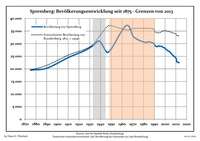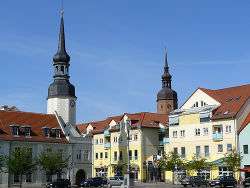Spremberg
| Spremberg/Grodk | |||
|---|---|---|---|
|
Market square | |||
| |||
 Spremberg/Grodk | |||
Location of Spremberg/Grodk within Spree-Neiße district  | |||
| Coordinates: 51°34′18″N 14°22′46″E / 51.57167°N 14.37944°ECoordinates: 51°34′18″N 14°22′46″E / 51.57167°N 14.37944°E | |||
| Country | Germany | ||
| State | Brandenburg | ||
| District | Spree-Neiße | ||
| Government | |||
| • Mayor | Christine Herntier (Ind.) | ||
| Area | |||
| • Total | 202.31 km2 (78.11 sq mi) | ||
| Population (2015-12-31)[1] | |||
| • Total | 22,818 | ||
| • Density | 110/km2 (290/sq mi) | ||
| Time zone | CET/CEST (UTC+1/+2) | ||
| Postal codes | 03130 | ||
| Dialling codes | 03563 | ||
| Vehicle registration | SPN, FOR, GUB, SPB | ||
| Website | www.stadt-spremberg.de | ||
Spremberg (Lower Sorbian: Grodk) is a city near to the Saxon city of Hoyerswerda in the Spree-Neiße district of Brandenburg, Germany. The town was first mentioned in 1301. The town alone has 9,203 inhabitants, whereas the town include other villages has 25,952 inhabitants.
Geography
Spremberg is situated about 20 km south of Cottbus and 25 km north of Hoyerswerda, on an island and on both banks of the river Spree. Between 1871 and 1918 the town was the geographical centre of the German Empire: today, it is only 25 km from the German-Polish border. On 1 January 2016, the former municipality Hornow-Wadelsdorf became part of Spremberg.
Demography
 Development of Population since 1875 within the Current Boundaries (Blue Line: Population; Dotted Line: Comparison to Population Development of Brandenburg state; Grey Background: Time of Nazi rule; Red Background: Time of Communist rule)
Development of Population since 1875 within the Current Boundaries (Blue Line: Population; Dotted Line: Comparison to Population Development of Brandenburg state; Grey Background: Time of Nazi rule; Red Background: Time of Communist rule) Recent Population Development (Blue Line) and Forecasts
Recent Population Development (Blue Line) and Forecasts
|
|
|
|
Culture
In 1911 there were Roman Catholic and two Protestant churches and a pilgrimage chapel dating from 1100, there was a ducal chateau built by a son of the elector John George around the end of the 16th century (now used as government offices), and there were classical, technical and commercial schools as well as a hospital.
Schwarze Pumpe
Schwarze Pumpe (Lower Sorbian: Čorna Pumpa) is a district of Spremberg, lying approximately 7 km southwest of Spremberg's town centre on the federal state boundary between Brandenburg to Saxony. It had 1988 inhabitants as of 1 January 2006. A large industrial area extending into Saxony and including the site of a large power plant is known by the same name.
On 26 May 2006, construction work started on the world's first CO
2-free coal power plant in the Schwarze Pumpe industrial district. The plant is based on a concept called carbon capture and storage, which means that carbon emissions will be captured and compressed to 1⁄500th their original volume, liquefying the gas. It will then be forced 1,000 metres (3,300 ft) below the soil into porous rock where it is believed that it will remain for thousands of years without exacerbating global warming. The project, which has cost some 70 million Euros, was funded entirely by the Swedish company Vattenfall AB and will go into service in September 2008. The power plant is a pilot project to serve as a prototype for future full-scale power plants.[3]
References
- ↑ "Bevölkerung im Land Brandenburg nach amtsfreien Gemeinden, Ämtern und Gemeinden 31. Dezember 2015 (Fortgeschriebene amtliche Einwohnerzahlen auf Grundlage des Zensus 2011)". Amt für Statistik Berlin-Brandenburg (in German). 2016.
- ↑ Detailed data sources are to be found in the Wikimedia Commons.Population Projection Brandenburg at Wikimedia Commons
- ↑ Germany leads 'clean coal' pilot, BBC News, 2008-09-03
External links
-
 Media related to Spremberg at Wikimedia Commons
Media related to Spremberg at Wikimedia Commons  "Spremberg". Encyclopædia Britannica. 25 (11th ed.). 1911.
"Spremberg". Encyclopædia Britannica. 25 (11th ed.). 1911.


